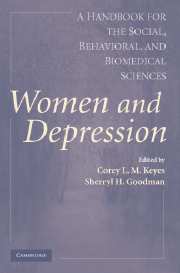Book contents
- Frontmatter
- Contents
- List of Contributors
- Foreword
- Preface
- PART I NOSOLOGY, MEASUREMENT, AND THE EPIDEMIOLOGY OF WOMEN AND DEPRESSION
- 1 Depression
- 2 The Epidemiology of Depression among Women
- PART II BIOLOGICAL, DEVELOPMENTAL, AND AGING MODELS OF RISK
- PART III COGNITIVE, EMOTIONAL, AND INTERPERSONAL MODELS OF RISK
- PART IV SOCIAL, POLITICAL, AND ECONOMIC MODELS OF RISK
- PART V SYSTEMS AND PROCESSES OF TREATMENT, PREVENTION, AND POLICY
- Author Index
- Subject Index
- References
2 - The Epidemiology of Depression among Women
Published online by Cambridge University Press: 05 June 2012
- Frontmatter
- Contents
- List of Contributors
- Foreword
- Preface
- PART I NOSOLOGY, MEASUREMENT, AND THE EPIDEMIOLOGY OF WOMEN AND DEPRESSION
- 1 Depression
- 2 The Epidemiology of Depression among Women
- PART II BIOLOGICAL, DEVELOPMENTAL, AND AGING MODELS OF RISK
- PART III COGNITIVE, EMOTIONAL, AND INTERPERSONAL MODELS OF RISK
- PART IV SOCIAL, POLITICAL, AND ECONOMIC MODELS OF RISK
- PART V SYSTEMS AND PROCESSES OF TREATMENT, PREVENTION, AND POLICY
- Author Index
- Subject Index
- References
Summary
Nonbipolar major depression is estimated by the World Health Organization (WHO) Global Burden of Disease (GBD) Study to be the leading cause of disease-related disability among women in the world today (Murray & Lopez, 1996). This conclusion is based on epidemiological data that have documented a high prevalence of major depression among women around the world in conjunction with estimates of disease burden based on expert judgements. This chapter reviews the epidemiological research that underlies the WHO GBD estimates as well as more recent epidemiological research on women and depression. The discussion begins with a review of basic descriptive epidemiological patterns and then turns to epidemiological evidence about the cause of the higher prevalence of depression among women than men.
PREVALENCE
The fact that women have a higher prevalence of depression than do men is one of the most widely documented findings in psychiatric epidemiology, having been found throughout the world using a variety of diagnostic schemes and interview methods (Andrade et al., 2003; Nolen-Hoeksema, 1987). The prevalence of major depression among women in community epidemiological studies is typically estimated to be between one and a half and three times that of men, although there is enormous variation in the estimated total population prevalence of major depression across these studies. Lifetime prevalence estimates of major depressive episode range between 6 and 17%. Twelve-month prevalence estimates range between 1 and 10%. Current prevalence estimates range between less than 1 and 6%.
- Type
- Chapter
- Information
- Women and DepressionA Handbook for the Social, Behavioral, and Biomedical Sciences, pp. 22 - 38Publisher: Cambridge University PressPrint publication year: 2006
References
- 51
- Cited by



